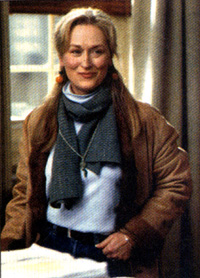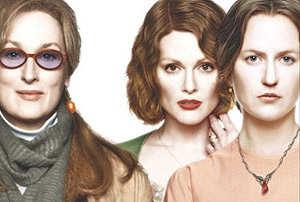 |
Movie Reviews
The Hours: A Moral Abyss
The Hours reviewed by Marian T. Horvat
The Hours begins with the final act in the life of feminist author Virginia Woolf. [1] In the early morning of March 28, 1941, Woolf loaded her pockets with stones and calmly walked into the River Ouse near her Sussex home until she was completely submerged. It was a methodical, slowly committed suicide that inspires horror.
But in the world of The Hours, the message is not supposed to be one of horror. Not at all. A life has ended, but one is given to understand that another reality has begun. Not hell, which would come to the mind of any good Catholic. What is implied is that her soul mysteriously migrated, like a bird, to land in another person in some other place. This mysterious reality can be understood only by poets and superior souls. Suicide would be, then, an acceptable and even laudable option - at least for such souls, an escape from the unbearable reality and stress of modern life.

Nicole Kidman, left, plays a romanticized version of the real Virginia Woolf, right |
Based on Michael Cunningham’s Pulitzer-prize winning book by the same title, The Hours is presented as a tribute to Virginia Woolf and her novel Mrs. Dalloway. Woolf’s novel took one day in the life of Clarissa Dalloway, an English matron, who is planning a party all the while ruminating on suicide. At the same time, Woolf spins in and out of the day of another character in a different place, a poet who actually commits suicide.
The Paramount film takes this theme and follows “the hours” in one day of the lives of three women who live in different times. The first is Virginia Woolf herself (Nicole Kidman) whom we see on the days she begins to write Mrs.Dalloway. She seems a crazy, unbalanced woman, unhappily married with lesbian tendencies, but this, or so the movie implies, is the reaction of the unenlightened. For those with eyes to see, she is a superior person, a misunderstood genius who receives her inspiration from “voices,” We never know whether these unexplained voices are a paranormal phenomena or the results of Spiritism; at any rate reference to those voices was something that for me smelled more of the devil than genial spirits.
In the movie she plays a “prophetic” role, prefiguring what will happen decades later in the lives of two other women, both lesbians struggling with a analogous sense of the futility of life and influenced by the book she is writing. One of these other women is Laura Brown (Julianne Moore), a suburban housewife in LA in the 1950s, pregnant and mother of a young son, who is helping her to prepare a birthday dinner for her husband. The other is a “liberated” New York editor of 2001, (Meryl Streep), who shares Mrs. Dalloway’s first name, Clarissa. She is preparing a party for Richard, a poet friend dying of AIDS. These, then, are the three women. What are the connections?

Meryl Streep in the shameless role of Clarissa, an open lesbian |
Woolf’s lesbian tendency is realized openly in Clarissa, the modern New York editor who lives with her female “partner” in a blatantly scandalous relationship. This Clarissa, officially lesbian, is nonetheless still dominated psychologically by a past and fleeting amour, the poet and author Richard, a homosexual, who has just received an award. One is supposed to have pity for this highly disagreeable emaciated figure in the last stages of the AIDS disease, and admire him as another “genius,” another “superior” person who hears “voices.” This man is presented as the heir to the “genius” and “voices“ of Virginia Woolf. He also ends by committing suicide. That is what “superior people” do in the world of The Hours.
Now, we come to the mystery of the movie – how does the “genius” of the insane lesbian author Virginia Woolf pass to the mad homosexual poet Richard? An unexpected link is provided by Laura, the discontented suburban housewife, also with lesbian tendencies. Reading the book Mrs. Dalloway, she comes to the realization of these tendencies. As she tries to comfort her good friend who has cancer, she gives her a scandalous and passionate kiss. Unobserved, her son, a young boy of about five years, is silently watching every move and mood of his mother.
At the moment Laura passionately kisses the woman friend, her son is watching from behind a couch. It is this scene that provides the link. The boy, in the shock of that scene, receives the mad “genius” of Virginia Woolf. The movie makes this clear with another flashback to the day of Woolf, who, so to speak, foresees the transmission in a scene with another young child, her niece. The young girl brings her a dead bird, which leads the author to wonder about life after death. What will it be like? Where will the soul go? The dead bird seems so peaceful, far removed from life in the wicked world where happiness is always elusive.
The bird, then, is the symbol of the “genius” that leaves Woolf when she commited suicide, migrates, and lands in the traumatized soul of a boy decades later in California. For this boy, son of the lesbian housewife Laura, is Richard the poet, Clarissa’s friend, the homosexual dying of AIDS who can likewise only be free by jumping from the window of his miserable skyscraper apartment to his death. The message is repeated: there is no understanding on this earth for “superior” souls. The bird flies off again.
And what about his mother? Like Mrs. Dalloway, she contemplates suicide, and even tries to carry it out, but at the last moment, she becomes fearful, for herself as well as the baby she is carrying, and returns to her unhappy existence as wife and mother. She lacks the courage of the “truly superior” Woolf and Richard. However, she does gather up enough “courage” to make a decision: After the birth of her baby, she will abandon her husband and children in order to be “free” to lead her own life, with intimations that she embarked also on a lesbian life. This is her “superior act,” her act of “virtue” in this warped and degenerate world of The Hours.

The story of three deviant women is not worth seeing |
In short, there you have it, three lesbian lives interwoven and interconnected in different times and spaces.
Morally speaking, this film is absolutely repugnant. It blasts a clear message of tolerance for homosexual men and women. It pretends to the normalcy and even the “superiority” of homosexuality. There is no outright pornography, but there are several lesbian kisses that were, for me, so uncomfortable and insupportable I finally had to leave the theater before the end. These unnatural kisses, presented as something normal and nice, are more revolting than anything I have ever seen.
Why even bother to review a movie I couldn’t bear to watch to the end?
For several reasons. First, as a warning to women, the target audience, who might be tempted to view the film because of the well-publicized appearances of a kind of super-team of actresses – Kidman, Moore, and Streep. The stars have been highly praised for their performances; the film was nominated for the Best Picture Academy Award, and Kidman actually received the prize of Best Actress for her portrayal of Virginia Woolf. Don’t be fooled, ladies. This is not a winner, and not worth seeing.
Second, as a warning to parents. The film is rated PG-13, suitable for youth age 13 and over with parental guidance, so one is led to believe it is not pornographic, safe for teens. If a parent were to read the movie reviews that I skimmed in several Catholic magazines, which made no mention of the complete amoral ambience, the lesbian relationships and the insupportable kisses, they would not realize how objectionable and dangerous this film really is. Before I entered the theater, I had no idea that the story was about three lesbian women, much less that it would promote this aberrant lifestyle as not only normal, but superior. This is a horrible message for youth, and especially young women, malleable and impressionable by nature. And what about the very thinly veiled message that suicide is an acceptable option for the genius, the artist, the misunderstood or alienated man and woman?
How different from sound Catholic teaching, which views suicide as an act of despair, a mortal sin that leads to hell. The condemnable complacency about homosexuality also clashes with Church teaching which instructs that homosexual acts are terrible sins against nature that call out to heaven for God’s vengeance.
Obviously, one would do well to steer wide of the moral abyss of The Hours.

Posted on April 18, 2003
1 For readers who have been spared the benefits of a modern education, in which the works of Virginia Woolf have becomes part of the standard curriculum, let me provide a little background. Virginia Woolf has become a feminist heroine for her writings on the need for women to have money and careers of their own. Woolf is also famous as a member of the ill-famed Bloomsbury Group, the artsy little London clique celebrated for its open rejection of all social and moral norms, and better known for its complicated, promiscuous and frequently homosexual relationships than any real artistic accomplishment.
|
Movie Reviews | Home | Books | CDs | Search | Contact Us

© 2002- Tradition in Action, Inc. All Rights Reserved
|
 |
|